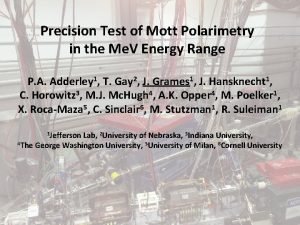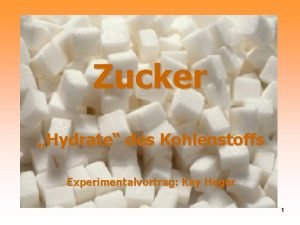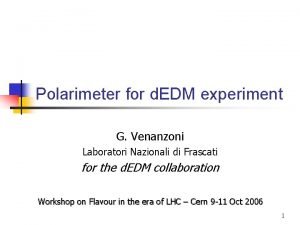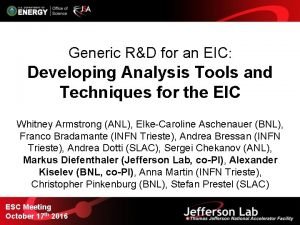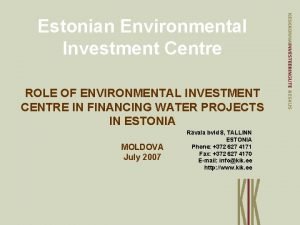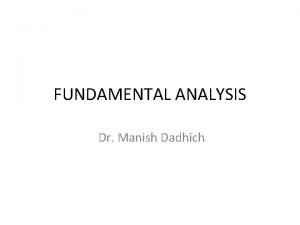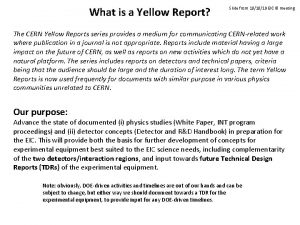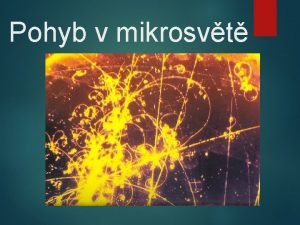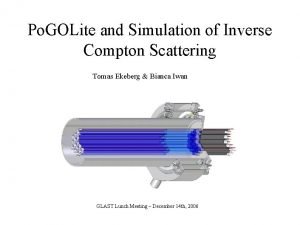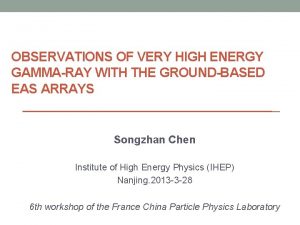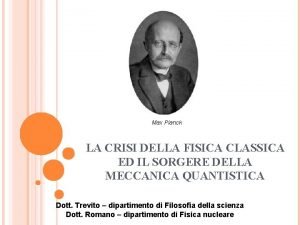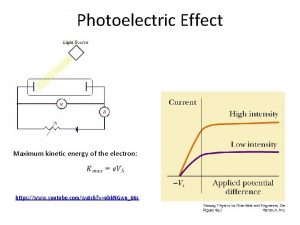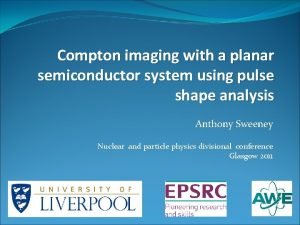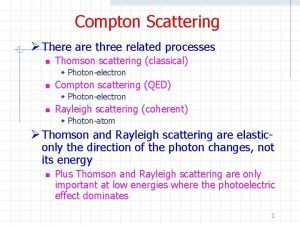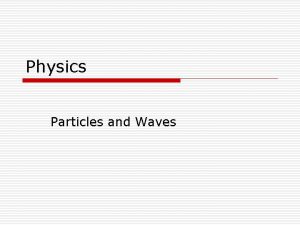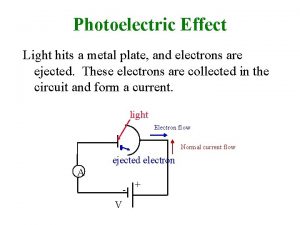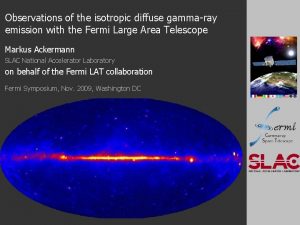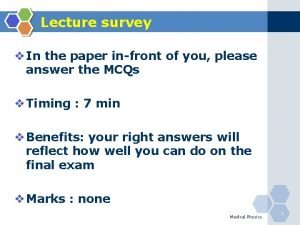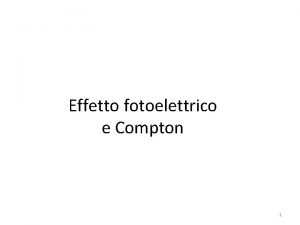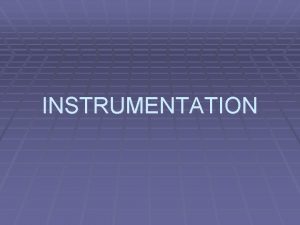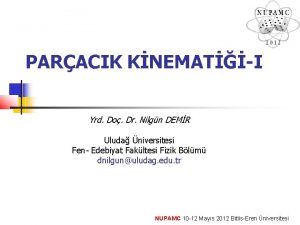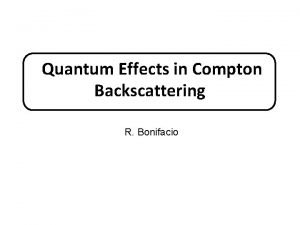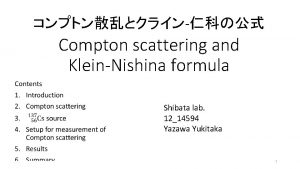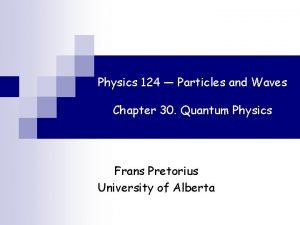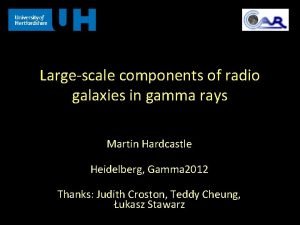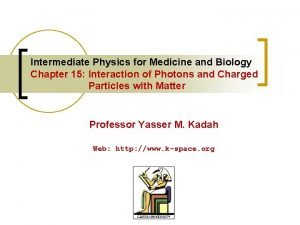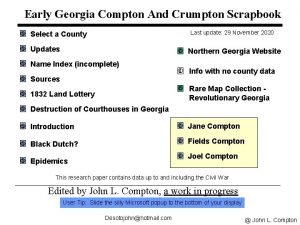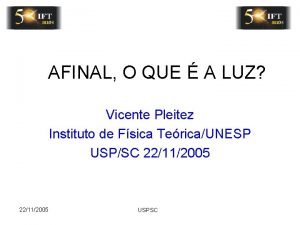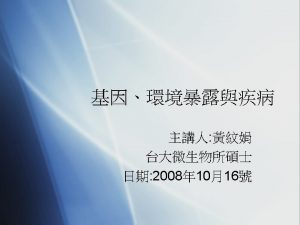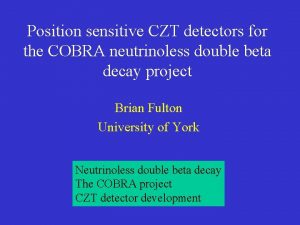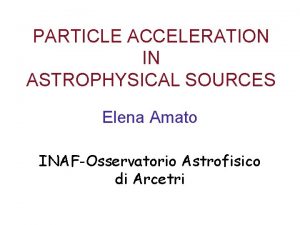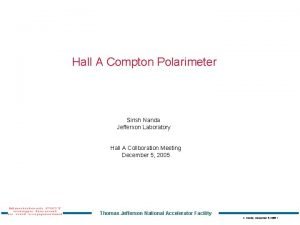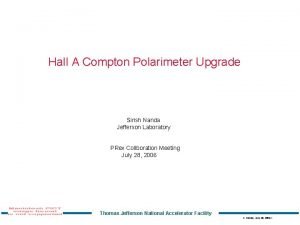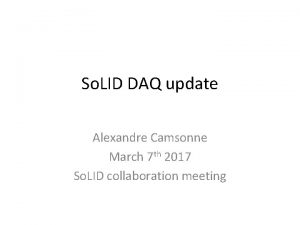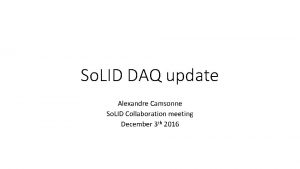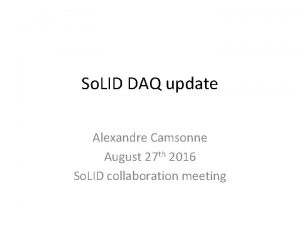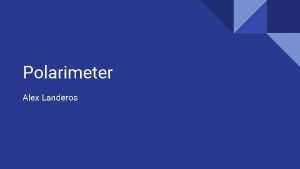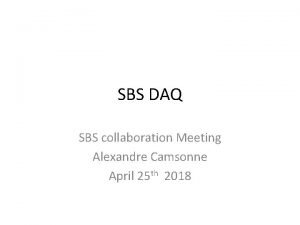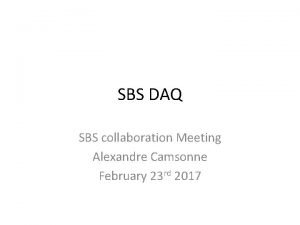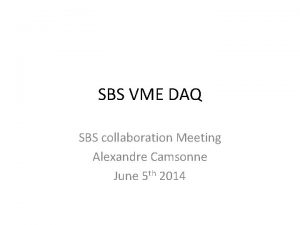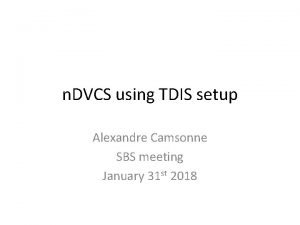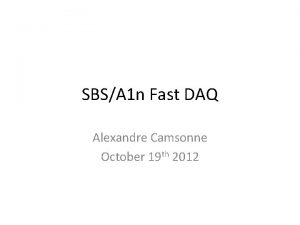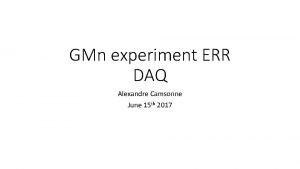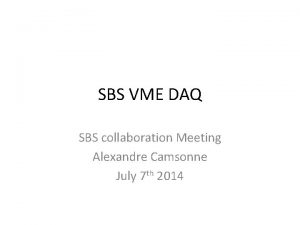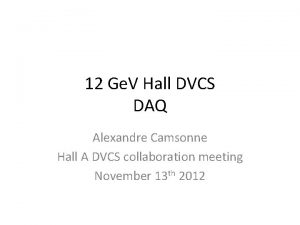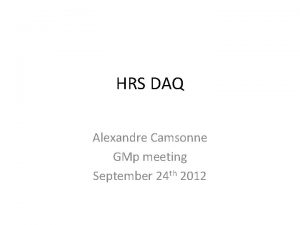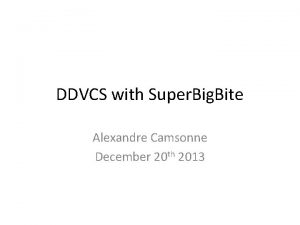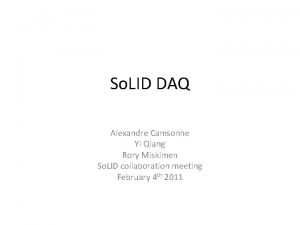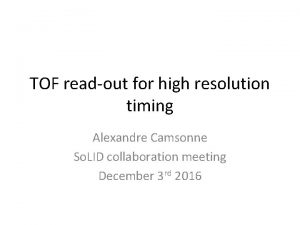Compton polarimeter update for EIC Alexandre Camsonne Jefferson










































- Slides: 42

Compton polarimeter update for EIC Alexandre Camsonne Jefferson Laboratory EIC R&D meeting January 22 nd 2015

ERHIC 8/29/2021 Electron Compton polarimeter update A. Camsonne • 6. 6 Ge. V to 21. 2 Ge. V • ~10 MHz Repetition rate • Up to 21 recirculations • 50 m. A with “gatling gun” design • 80 % min polarization • Similar to CEBAF Vadim Ptitsyn e. RHIC Accelerator Design EIC 2014 2

MEIC Warm large booster (up to 25 Ge. V/c) Three Figure-8 rings stacked vertically SRF linac Pre-booster Electron Warm 3 -12 Ge. V electron collider ring Medium-energy IPs with horizontal beam crossing Injector 12 Ge. V CEBAF 8/29/2021 cooling Ion source Cold 25 -100 Ge. V/c proton collider ring • Storage ring – Ring ring • 746 MHz • 3 A at 3 Ge. V and 180 m. A at 10 Ge. V • 2 macrobunch with one polarization 2. 3 us • Measure polarization average of the two macrobunch • Every electron bunch crosses every ion bunch Electron Compton polarimeter update A. Camsonne 3

Compton asymmetry s( e + g 8/29/2021 e’ + g’ ) s( e + g Electron Compton polarimeter update A. Camsonne e’ + g’ ) 4

Low Q 2 chicane and Compton w o L Q 2 e n a c c i h Compton detectors 8/29/2021 Electron Compton polarimeter update A. Camsonne 5

MEIC Bunch Structure In Collider Ring bunch train & polarization pattern in the collider ring Empty buckets 1. 33 ns 748. 5 MHz … 6 8/29/2021 Empty buckets … … 2. 3μs, ~1700 bunches Polarization (Up) Polarization (Down) Electron Compton polarimeter update A. Camsonne …

MEIC Bunch Pattern for Continuous Injection 2. 3μs, ~1700 bunches 1. 33 ns, 748. 5 MHz 173. 5 p. C 1. 33 ns, 748. 5 MHz duty factor 4. 3 e-4 173. 5 p. C …… …… duty factor 6. 9 e-4 Macro bunch train …… 100 ms (~4 damping time) 1 s, , Iave=6μA 1 second Detector duty factor 0. 98 duty factor 0. 0167 60 s …… Iave=100 n. A At 100 n. A average injected current, Pequ/P 0> 96% for the whole energy range 7 8/29/2021 Electron Compton polarimeter update A. Camsonne

Polarization Collision Pattern • HERA: – Each ion bunch only sees the same electron bunch ion electron • MEIC: – Each ion bunch sees all electron bunches ion electron – No non-colliding bunches Therefore, in the MEIC – Bunch-to-bunch variation does not contribute to the uncertainty – One can measure average polarization Electron Compton polarimeter updateof each macro bunch train 8/29/2021 8 A. Camsonne

Time structure • Bunch to bunch : 1. 33 ns • Polarization state : 2. 3 us + 2. 3 us • Measure asymmetry for one laser state and polarization 8/29/2021 Electron Compton polarimeter update A. Camsonne 9

ERHIC 8/29/2021 Electron Compton polarimeter update A. Camsonne • 5 Ge. V to 21. 2 Ge. V • 10. 8 MHz Repetition rate • 50 m. A with “Gatling gun” design with 20 sources • Need to measure each sources polarization • 80 % min polarization • Similar to CEBAF 10

e. RHIC beam parameters • 50 m. A with up to 20 sources • 10. 8 MHz repetition rate • ERL LINAC allows helicity structure with helicity flip from the source • Need individual measurement of each source – 100 ns max for each measurement – Logic signal to flag which source is recorded • Rates sufficient to measure all sources in a few minutes 8/29/2021 Electron Compton polarimeter update A. Camsonne 11

Compton rates • Green laser, 1. 3 degrees crossing angle • beam 350 um Energy Rate ( k. Hz/W/A) Max current (A) Rate k. Hz/W e. RHIC current (A) Rate (k. HZ/W) 3 316 3 948 0. 05 15. 8 5 298 3 894 0. 05 14. 9 6 290 2 580 0. 05 14. 5 7 283 1. 1 311. 3 0. 05 14. 1 9 269 0. 4 107. 6 0. 05 13. 4 11 258 0. 18 46. 44 0. 05 12. 9 • laser of a few watts : 10 KHz to 1 MHz - sufficient statistics in a few seconds • 1000 W cavity : rates from tens of KHz to MHz level ( if background high ) 8/29/2021 Electron Compton polarimeter update A. Camsonne 12

Electron detector implementation in low Q 2 Compton polarimeter in low-Q 2 chicane Same polarization as at the IP due to zero net bend Non-invasive continuous polarization monitoring Polarization measurement accuracy of ~1% expected No interference with quasi real photon tagging detectors Laser or Fabry Perot cavity Photon calorimeter c Quasi-real high-energy photon tagger Quasi-real low-energy photon tagger Electron tracking detector 5 m 4 m D = -22. 4 cm D’ = -0. 04 At 10 Ge. V assume L = 5 m Compton edge : 2. 6 Ge. V = 5. 8 cm. Electron +0. 0104*L 10. 84 cm Compton=polarimeter update 8/29/2021 A. Camsonne Zero crossing 1. 514 Ge. V = 3. 39 cm + 0. 006*L = 6. 39 cm e- beam 5 m Detector in vacuum 13

Chicane • Different type of magnet for • dipole 1 and 4 can be C magnets • Dipole 2 and 3 can be C magnets in other direction or open dipoles Laser + Fabry Perot cavity Photon calorimeter c Quasi-real high-energy photon tagger Quasi-real low-energy photon tagger Electron tracking detector 8/29/2021 Beam size shrinks with Electron Compton polarimeter update A. Camsonne point : reduction distance to interaction e- beam of halo in detector 14

Simulation • Simulation Dave Gaskell ( small aperture ) 15 meter setup Photon • Very sensitive to Halo • Simulation for cavity design Electron 8/29/2021 Electron Compton polarimeter update A. Camsonne 15

Simulation • Simulation Dave Gaskell ( large aperture ) 15 meters setup Photon Electron 8/29/2021 Electron Compton polarimeter update A. Camsonne 16

Photon detector Synchrotron radiation study (Mike Sullivan) 8/29/2021 Electron Compton polarimeter update A. Camsonne 17

Beam pipe 8/29/2021 Electron Compton polarimeter update A. Camsonne X-ray reduction 18

Sloped beam pipe Need <10 W / mm 8/29/2021 Electron Compton polarimeter update A. Camsonne 19

Energy deposit in photon detector for different shielding Need to evaluate effect on detector performances 8/29/2021 Electron Compton polarimeter update A. Camsonne 20

Radiation dose E Loss(Me. V/ cm-1) L Thickness Width Volume (cm^3) Density Mass (g) 3. 87 5 0. 025 0. 035 0. 004375 2. 329 0. 0101893 75 3 MRad Energy Rate (k. Hz/A/W) Current Rate k. Hz 1/Rate (s) E deposit (Me. V/W) E deposit (J/W) Dose (rad/W) 3 316 3 948 1. 05 E-06 3. 67 E+06 5. 87 E-07 5. 76 E+00 2. 07 E+04 4. 98 E+05 6. 03 E+00 5 298 3 894 1. 12 E-06 3. 46 E+06 5. 54 E-07 5. 43 E+00 1. 96 E+04 4. 69 E+05 6. 39 E+00 6 290 2 580 1. 72 E-06 2. 24 E+06 3. 59 E-07 3. 52 E+00 1. 27 E+04 3. 05 E+05 9. 85 E+00 7 283 1. 1 311. 3 3. 21 E-06 1. 20 E+06 1. 93 E-07 1. 89 E+00 6. 81 E+03 1. 63 E+05 1. 84 E+01 9 269 0. 4 107. 6 9. 29 E-06 4. 16 E+05 6. 66 E-08 6. 54 E-01 2. 35 E+03 5. 65 E+04 5. 31 E+01 10 258 0. 18 46. 44 2. 15 E-05 1. 80 E+05 2. 88 E-08 2. 82 E-01 1. 02 E+03 2. 44 E+04 1. 23 E+02 3 316 0. 05 15. 8 6. 33 E-05 6. 11 E+04 9. 78 E-09 9. 60 E-02 3. 46 E+02 8. 30 E+03 3. 62 E+02 5 298 0. 05 14. 9 6. 71 E-05 5. 77 E+04 9. 23 E-09 9. 05 E-02 3. 26 E+02 7. 82 E+03 3. 83 E+02 6 290 0. 05 14. 5 6. 90 E-05 5. 61 E+04 8. 98 E-09 8. 81 E-02 3. 17 E+02 7. 61 E+03 3. 94 E+02 7 283 0. 05 14. 15 7. 07 E-05 5. 48 E+04 8. 76 E-09 8. 60 E-02 3. 10 E+02 7. 43 E+03 4. 04 E+02 9 269 0. 05 13. 45 7. 43 E-05 5. 21 E+04 8. 33 E-09 8. 17 E-02 2. 94 E+02 7. 06 E+03 4. 25 E+02 8/29/202111 258 0. 05 Electron Compton polarimeter update 12. 9 7. 75 E-05 4. 99 E+04 7. 99 E-09 A. Camsonne 7. 84 E-02 2. 82 E+02 6. 77 E+03 21 4. 43 E+02 MEIC e. RHIC Dose /hour Dose / day N days

Radiation hardness Eloss (Me. V/cm-1) L Thickness Width Volume (cm^3) Density Mass (g) 3. 87 5 0. 025 0. 035 0. 004375 2. 329 0. 0101893 75 3 MRad Energy Rate(k. Hz/A /W) Current Rate k. Hz 1/Rate (s) E deposit (Me. V) J Dose (rad) Dose per hour (rad) Dose / day (rad) N days 3 316 3 948000 1. 05 E-09 3. 67 E+09 5. 87 E-04 5. 76 E+03 2. 07 E+07 4. 98 E+08 6. 03 E-03 5 298 3 894000 1. 12 E-09 3. 46 E+09 5. 54 E-04 5. 43 E+03 1. 96 E+07 4. 69 E+08 6. 39 E-03 6 290 2 580000 1. 72 E-09 2. 24 E+09 3. 59 E-04 3. 52 E+03 1. 27 E+07 3. 05 E+08 9. 85 E-03 7 283 1. 1 311300 3. 21 E-09 1. 20 E+09 1. 93 E-04 1. 89 E+03 6. 81 E+06 1. 63 E+08 1. 84 E-02 9 269 0. 4 107600 9. 29 E-09 4. 16 E+08 6. 66 E-05 6. 54 E+02 2. 35 E+06 5. 65 E+07 5. 31 E-02 10 258 0. 18 46440 2. 15 E-08 1. 80 E+08 2. 88 E-05 2. 82 E+02 1. 02 E+06 2. 44 E+07 1. 23 E-01 3 316 0. 05 15800 6. 33 E-08 6. 11 E+07 9. 78 E-06 9. 60 E+01 3. 46 E+05 8. 30 E+06 3. 62 E-01 5 298 0. 05 14900 6. 71 E-08 5. 77 E+07 9. 23 E-06 9. 05 E+01 3. 26 E+05 7. 82 E+06 3. 83 E-01 6 290 0. 05 14500 6. 90 E-08 5. 61 E+07 8. 98 E-06 8. 81 E+01 3. 17 E+05 7. 61 E+06 3. 94 E-01 7 283 0. 05 14150 7. 07 E-08 5. 48 E+07 8. 76 E-06 8. 60 E+01 3. 10 E+05 7. 43 E+06 4. 04 E-01 9 8/29/2021 11 269 0. 05 8. 17 E+01 2. 94 E+05 7. 06 E+06 258 0. 05 13450 7. 43 E-08 5. 21 E+07 8. 33 E-06 Electron Compton polarimeter update A. Camsonne 12900 7. 75 E-08 4. 99 E+07 7. 99 E-06 7. 84 E+01 2. 82 E+05 6. 77 E+06 4. 25 E-01 22 4. 43 E-01 MEIC e. RHIC

Detector technologies • Radiation hard ( 3 m. A current ! ) – Diamond – Silicon ( regular/ high radiation / cryo cooled ) – ASIC readout ( need evaluate radiation hardness ) • Radiation hard and fast ( less 100 ns ) – Superconducting detector Nb. N Nb. Ti – Quartz detector • All in vacuum • Roman pot option 8/29/2021 Electron Compton polarimeter update A. Camsonne 23

Compton photon vs electron • Past experience – HERA photon only longitudinal and transverse (1. 4 % ) – SLAC : SLD electron detection 50 Ge. V best Compton measurement ever made 0. 5 % ( large energy, large dispersion, low rates ) • For Compton electron – Larger displacement the better for improved resolution and signal to background ratio – Opposite requirement to photon detection where minimum is sought to reduce • Need to evaluate optimum case : photon only, photon and electron detection, electron detection only • 2 Ips : – one optimized for photon small displacement, longer chicane and magnet to reduce synchrotron radiation – one optimized for electron with larger displacement 8/29/2021 Electron Compton polarimeter update A. Camsonne 24

EIC standard setup • Easy to additional detectors • Need to start looking at background • Shielding and collimation optimization GEMC • 8/29/2021 Electron Compton polarimeter update A. Camsonne 25

Simulation Low Q 2 electrons Compton Photon detector Very low Q 2 electrons 8/29/2021 Electron Compton polarimeter update A. Camsonne Compton electron detector 26

Simulation 8/29/2021 Electron Compton polarimeter update A. Camsonne 27

Magnet modelling • Opera 3 D Tosca • Use Hall A model as starting point • Design iron • Low Q 2 exit • Chamber • Generate accurate fields 8/29/2021 Electron Compton polarimeter update A. Camsonne 28

Hall A JLAB 12 Ge. V status • First run above 6 Ge. V : 7. 3 Ge. V • 2 weeks of physics • Next run February to May 2015 ( 5 pass 10 Ge. V ) – Tune through Compton chicane – Test Pb. WO 4 integrating method – Test electron detector 8/29/2021 Electron Compton polarimeter update A. Camsonne 29

Hall A Compton chicane Photon detector on movable table 8/29/2021 Electron Compton polarimeter update A. Camsonne Vertical motion of electron detector to move detector close to the beam ( up to 5 mm ) 30

Roman pot technique evaluation in Compton test stand • Need to evaluation contribution of window • Evaluate gain in cabling complexity with full vacuum solution 8/29/2021 Electron Compton polarimeter update A. Camsonne 31

Updated quote • Bellow expensive • Simpler design – Cheaper – More down time – Similar design – Chamber compatible with silicon, diamond or test detector – Top chamber swap for detector change ( need break vacuum ) 8/29/2021 Electron Compton polarimeter update A. Camsonne 32

To do list • • • Full background simulation Evaluation of radiation dose Detector cooling RF shielding Beam pipe, chambers, magnets Fast radiation hard photon and electron detectors – Design chamber for electron detector – Can test photon detector any time • Counting vs integrated 8/29/2021 Electron Compton polarimeter update A. Camsonne 33

Conclusion • Photon detection need to study effect of shielding • Electron detection – Halo contribution would be useful – Simulation in GEMC for background studies – Need to handle rate and radiation 8/29/2021 Electron Compton polarimeter update A. Camsonne 34

Backup 8/29/2021 Electron Compton polarimeter update A. Camsonne 35

Synchrotron radiation in detector with different shielding 5 Ge. V 8/29/2021 Electron Compton polarimeter update A. Camsonne 36

Synchrotron radiation in detector with different shielding 11 Ge. V 8/29/2021 Electron Compton polarimeter update A. Camsonne 37

Single Superconducting Nanowire Photon Detectors (SNSPD) • Thin superconducting stripe of 5 to 10 nm thickness • Meander geometry to maximize surface, typical width of strip 10 nm and length about 100 nm • Signal speed depends on material, substrate and geometry • Mostly developed for astrophysics with IR sensitivity : Nasa Jet Propulsion Laboratory, Lincoln Laboratory …. 8/29/2021 Electron Compton polarimeter update A. Camsonne 38

Comments from report • The requirements for bunch-to-bunch accuracy of the polarization measurement are essential, but have not been specified. An evaluation of rates and the development of a scheme, which satisfies the requirements for bunch-to-bunch accuracy of the polarization measurement, are essential. A further study of the backgrounds and efforts to find ways how to reduce it, have a high priority. • The committee considers a high-quality polarization-measurement program essential for EIC and supports the idea of a “Compton polarimeter test bed”. It recommends that the detailed requirements on polarization knowledge be worked out and the resulting detector specifications evaluated, for both EIC machine designs. A close contact between the other groups working on EIC polarization and the machine experts from both EIC machine designs is strongly encouraged. 8/29/2021 Electron Compton polarimeter update A. Camsonne 39

Comments from report • In the proposal a clear presentation of the requirements in terms of bunch-to-bunch accuracy, time in which this accuracy has to be achieved, radiation dose in the sensor, and last but not least the rate required to achieve these goals are missing. The committee notes that colliders are repetitive machines and the fate of different bunches is not obviously guaranteed to be the same, due to bunch interactions with the machine structure and dependencies of emittance growth and instabilities on bunch charge. Some study is warranted here, even if the bunch crossing pattern allows all combinations as in MEIC. 8/29/2021 Electron Compton polarimeter update A. Camsonne 40

Reasons why polarization / Current CAN vary From Bunch to Bunch Polarization: Hadrons in a storage ring: source instabilities Beam-Beam effects bunch-to-bunch emittance variation, Characteristic scale can be seen from AGS RHIC polarization profile variation for different bunches after acceleration leptons in a storage ring: time t r o h s y ientl c i f f u s ing c n i n e n u o l i f s i rec rs in p e t l e a c i m t a s r i nd pa h stat a g u e : o t m n n i t e e eme. RHIC tion with leptons n of o i t c n Requirin a u f s lariz fluctuation ninapolarization oexpected o p q What is the from cathode to cathode i t e a r z u i r s a a l e o p m r in the gatling gun nito o m tical i o r t c s t e i r n a u from Jlab experience 3 -5% rimetry n o i t a ola ppolarization n lariz the possibility o q p. Isothere for a profile for the lepton bunches t p e l d n a n ro in the longitudinal direction can be circumvented with 352 MHz RF haif dthen Beam-Beam effects source instabilities Current: Hadrons & leptons in a storage ring: Variations in transfer efficiency from pre-accelerator to main ring beam-beam interaction is important, it affects the bunch lifetime during the store leptons in e. RHIC q What fluctuation in bunch current for the electron do we expect limited by Surface Charge, need. Electron to see. Compton what we obtainupdate from prototype gun polarimeter 8/29/2021 A. Camsonne 41

e. RHIC lepton polarimeter q Technology: Compton Back scattering q measure photon and lepton complementary & redundancy q e-Polarimeter location q at IP q overlap of Bremstrahlung and Compton photons q only possible if we have number of empty p-bunches = # cathodes in gatling gun luminosity loss q before/after IP q need to measure at location spin is fully longitudinal or transverse q 1/6 turn should rotate spin by integer number of π segmented Calorimeter longitudinal polarization Energy asymmetry transverse polarization component position asymmetry q After IP: q does collision reduce polarization problem at ILC for e. RHIC very small q need to measure at location, where bremsstrahlung contribution is small q Before IP: q need to find room for photon calorimeter q Introduce dog-leg for polarimeter q minimizes Bremstrahlung photon impact q creates synchroton radiation q Other considerations: q # of cathodes in gatling gun: golden number is 20 q This guarantees that a hadron bunch collides always with electrons produced from one particular cathode, avoiding/reducing significantly harmful beam-beam effect of electron beam parameter variations the hadrons Electronon Compton polarimeter update 8/29/2021 A. Camsonne 42
 Mott polarimeter
Mott polarimeter Furanosen
Furanosen Polarimeter
Polarimeter ........ is an alternative of log based recovery.
........ is an alternative of log based recovery. Yellow report eic
Yellow report eic Qa eic patel
Qa eic patel Eic health certificate
Eic health certificate Eic software software review
Eic software software review Eic european investment centre
Eic european investment centre Eic approach of fundamental analysis
Eic approach of fundamental analysis Kickoff meting
Kickoff meting Eic fiu
Eic fiu Arthur compton experiment
Arthur compton experiment Compton scattering
Compton scattering Efecto compton
Efecto compton Inverse compton
Inverse compton Apparato sperimentale effetto fotoelettrico
Apparato sperimentale effetto fotoelettrico Bohr atom modeli formülleri
Bohr atom modeli formülleri Www.youtube.com
Www.youtube.com Compton
Compton Hiệu ứng compton
Hiệu ứng compton Photon cross section
Photon cross section Derivation of compton effect
Derivation of compton effect Photoelectric effect formula
Photoelectric effect formula Isodosis
Isodosis Inverse compton
Inverse compton Equivalent dose formula
Equivalent dose formula Effetto fotoelettrico formula
Effetto fotoelettrico formula Compton
Compton Compton saçılması
Compton saçılması Compton scattering
Compton scattering Compton backscattering
Compton backscattering Gammra
Gammra Compton wavelength
Compton wavelength Stephenie compton email
Stephenie compton email Ngc 6251
Ngc 6251 Wierl equation
Wierl equation Keisoni
Keisoni Victorian curriculum economics and business
Victorian curriculum economics and business Efeito fotoelétrico einstein
Efeito fotoelétrico einstein James dewey watson y francis harry compton crick
James dewey watson y francis harry compton crick Aeronet compton
Aeronet compton Pion decay
Pion decay
